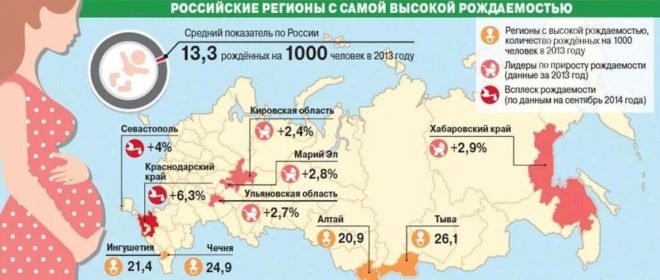What is fertility rate?
The concept of "fertility" is widely used not only by doctors who deal with issues of reproduction, because the term itself means the ability to reproduce. This concept is operated by sociologists, politicians, and specialists in the field of demography. But they use such a thing as "fertility rate".
What it is?
Fertility is the ability of men and women who have reached puberty and have not yet emerged from reproductive age to have offspring. Female fertility implies the ability to conceive, bear and give birth to a live child. Male is caused by the ability to fertilize female sex cells. To determine the level of fertility of individual representatives of the male and female sex in medicine, there is a system of tests and analyzes.
Fertility rate individual reproduction capacity is not measured.. This is a macroeconomic indicator expressing the number of live-born children in relation to the number of women who are of reproductive age. This indicator is very important for economic and social forecasts, for the description of certain political and demographic positions on the territory of a certain country, region, city, region, etc.
In reference books, fertility is more often denoted by another concept, which is synonymous with - average total fertility rate.
If you are interested in the birth rate in a particular country, then reference books and statistical portals will issue exactly this coefficient in response to the request.
Before the politicians of a particular country adopt any social laws, long-term state programs, they must be compared with the total fertility rate and demographers' forecasts for the coming years.
How is it calculated?
To calculate the coefficient, a special formula is used: K = N \ n * 1000. In it, K is the fertility rate (or total fertility rate), N is the number of newborns for a certain time period, n is the number of women who are in reproductive age (15–49 years). The answer is expressed in ppm.
The average level of fertility is 2.33. When it is society remains stable. A high coefficient is considered to be higher than 2.4 - there is population growth, overcrowding is not excluded. Low - 2.15 ppm and below. The population at this rate decreases.
Low fertility rates - an unfavorable prognosis for the demographic state of a country (region), low economic forecasts, because labor resources, if the coefficient does not rise, will soon be small. The high coefficient is associated with other problems: the likelihood of a shortage of jobs, the long-term prospect of depleting natural resources in a designated part of the world.
Therefore, the fertility rate is a kind of action guide for local government. With a low value - they introduce measures of demographic support, with a high one - restrictions on fertility.
Situation in the world
The global trend of the last decades is a decrease in the total fertility rate. Worldwide data is such that 60 years ago it was 4.95 ppm. And in 2010 it was 2.57 ppm. The birth rate has decreased almost twice. Experts attribute this to economic factors, to mass relocation to large cities, as well as to the deterioration of the reproductive health of women.The development of contraceptive production also played a role.
The world has the highest fertility rate in Africa today. For example, in Niger it is 7.16 ppm. The lowest fertility rate recorded by demographers in Singapore - 0.78 ppm.
The world average for 2015 is 2.36 ppm. In Russia, Rosstat calculated that the fertility rate for 2015 is 1.78 (very low values). In the cities it is even lower - 1.67 ppm, and in the villages - 2.11 ppm.
In which regions of Russia give birth more?
If we consider the statistics by regions of Russia for the last years (for the period from 2014 to 2017), then fertility rates will be heterogeneous.
- The leader in the birth rate is the Republic of Tyva - the coefficient in 2017 was 3.19 per thousand.
- Top 10 is as follows: Chechnya (2.37), Altai (2.36), Nenets Autonomous District (2.35), Chukotka Autonomous Region (2.08), Buryatia (2.06), Sakhalin (2, 03), Yamal-Nenets Okrug (1.95), the Republic of Sakha (1.93), Dagestan (1.91).
- The lowest birth rate was recorded in 2017 in the Leningrad region (1.22 ppm), as well as in the Republic of Mordovia (1.26 ppm).
In general, in all regions compared with 2014, the birth rate is falling, and only the republics of the North Caucasus demonstrate a certain increase in the fertility rate.












